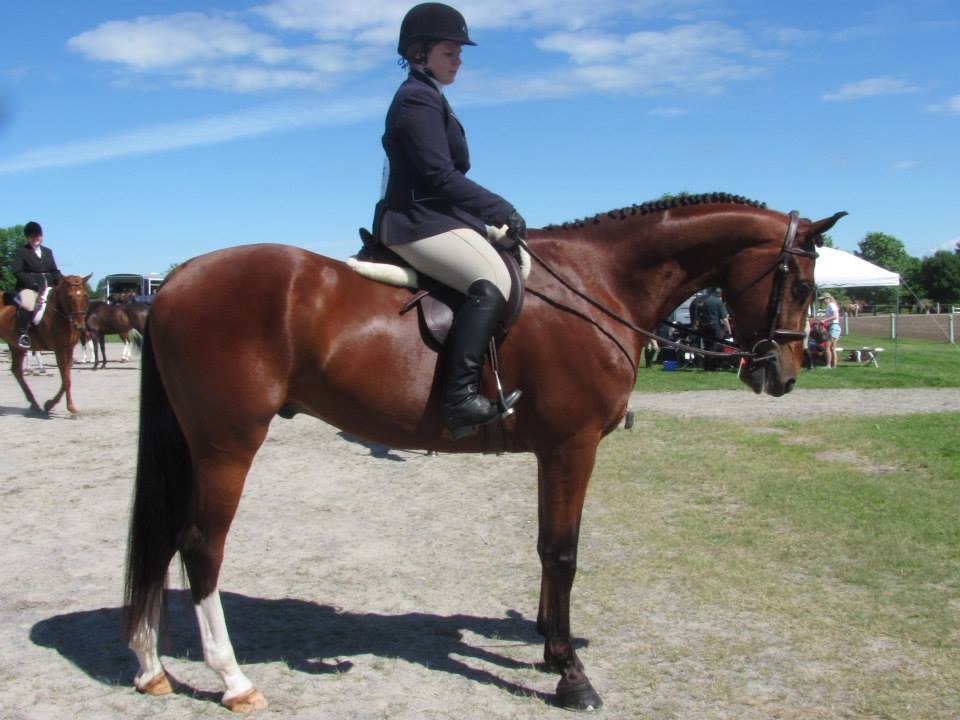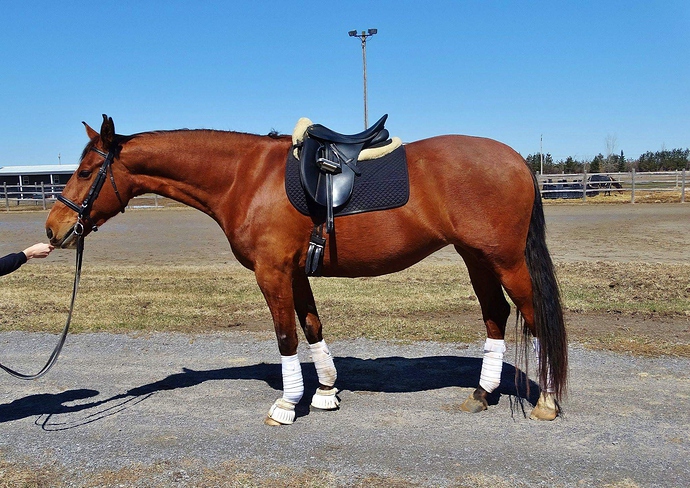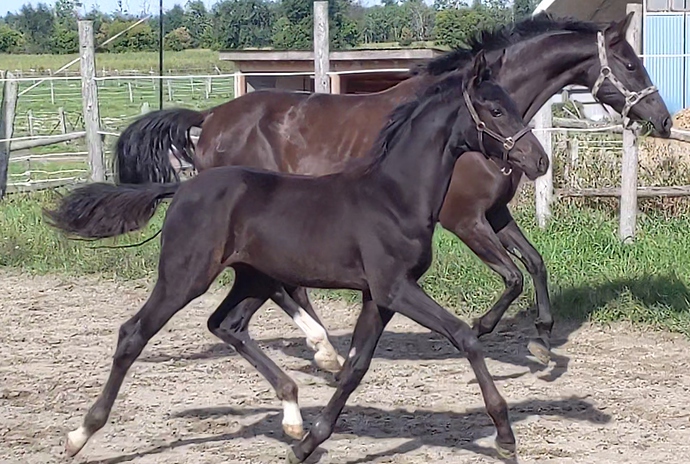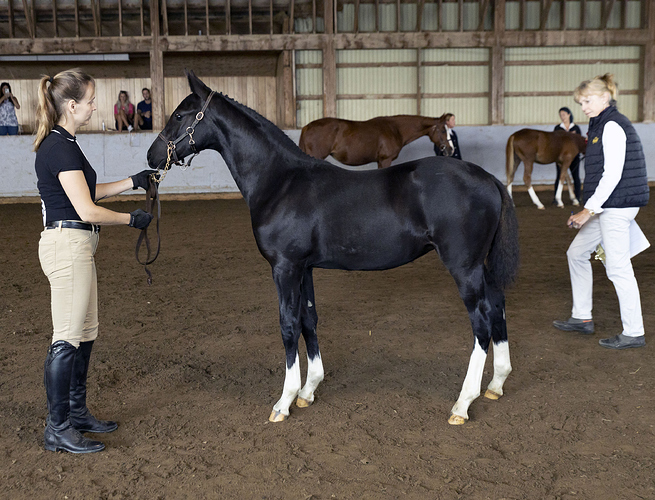Apparently my flame suit could not withstand this group. If you’re thinking of starting a thread about general thoughts, learn from my mistake and don’t. With few exceptions, you’ll be met with bullies, gaslighters and know it alls looking to project whatever the latest disaster is on you unless you parrot the party line and live in their echo chamber. May the odds be ever in your favor. 
It’s a great thought. I think the vast majority of riders want a quiet, well mannered mount, that can takes care of their riding needs. With that said, there is a reason why a lot of well bred horses end up on this side of the pond. It might look like a winner on paper, but at the end of the day horses are individuals. They can be bred to the 9s and still not meet that potential.
I don’t think there is anything wrong with breeding horses to a population of rider that isn’t looking for an Olympic mount. As long as the intention is to still breed quality to achieve it thats what should be considered.
Totally agree that we tend to get the European castoffs. I heard somewhere “Breed the best and ride the rest” that speaks to horses not reaching genetic potential. But unfortunately the reasons those horses don’t reach that potential often makes these horses even less suitable for the adult amateurs. Physical or mental issues that generally make them harder to ride and maintain. Especially in the dressage world currently, it seems the trend is to breed for extreme front end action and hyper mobility that just doesn’t hold up.
I think it’s why the draft crosses are popular with the dressage adult amateur world, but talk about unpredictable results!
My daughter uses a Morgan, the pair have been successful in open Class A dressage (as well within the breed), the horse is very smart, easy to train a very nice horse that is now valued in mid fives
As a change of pace the mare is also worked in western tack for ranch work
I think so. I never had trouble selling my Welsh Cobs, Welsh Cob x TB or Welsh Cob x Morgan crosses who were bred and chosen with ‘sports’, pure gaits and great disposition in mind. They were ammy owned, ammy produced as well as children tested and mother approved. There are Morgan breeders who focus on the same traits and successfully produce such animals which have competed through the levels as did those of the aforementioned breed/breed crosses. I guess I don’t agree that all ‘off breeds’ will struggle because I know many sectors within those off breeds who do focus on solid/clean conformation, soundness, disposition, athleticism, 3 pure gaits and trainability as a goal for their breeding program and aren’t just ‘breed’ oriented.
I agree, not all non-warmblood breeds struggle, that wasn’t an accurate statement. But I will say they are the exception not the rule, since most of these other breeds are bred for other disciples that require different strengths. I agree that ANY ethical breeding program is hopefully prioritizing soundness of mind and body, they are maybe breeding for a longer back and higher headset (saddleseat or driving focus) or speed vs collection (eventing or racing) etc.
IMHO, part of being purpose bred is having fairly consistent offspring which is harder with the crossbreds. Don’t get me wrong, I love a good crossbred horse (My favorite horse of all time was a Clyde/TB) but for a breeder it’s more of a roll of the dice.
Another part of my thought process is producing a quality but affordable horse. It really saddens me that a lot of adult amateurs are getting priced out of getting a quality (but not world beater) horse without having to make major concessions in soundness of mind and/or body. I may be talking to the wrong crowd here on this point  but it also makes me sad that people who are passionate about horses may not be able to afford to participate.
but it also makes me sad that people who are passionate about horses may not be able to afford to participate.
I think that there’s a great market for a really solid minded proven dressage horse even if it is a 6 mover. There are endless ISO ads of people shopping on smaller budgets who want good minded rideable horses. However, finding someone who wants to buy an average moving, average looking, but will hopefully stay structurally sound and not do something stupid and self inflicting birth-4 year old is a harder ask. Most people willing to take the risk at least want the possibility of something that won’t max out at lower levels or will be a head turner.
At the end of the day it isn’t much cheaper to breed an average 2nd level mare than to breed a brilliant one but the foal is going to command a much smaller price tag. While I don’t think it is really a wise business model, I think it is fairly safe to breed a sane, sound, WBx, TBx, Welshx, etc. if you are willing to keep it until going under saddle and provide a solid foundation and are okay not recouping your expenses.
I’d also argue it is a slippery slope and I think the idea is often used as justification for BYB types or the train wreck that is the DHH jumping thread. With gobs of OTTBs on the market and low end auctions abounding, how “average” is too average and the closer you breed to average the more spectular the brains and training need to be to compensate.
It’s a numbers game. Minus stud fee, and maybe initial purchase of the broodmare (but not always), it costs the same to get a fancy foal on the ground as it does an affordable animal. I’ve been told it’s quite easy to put $6k-$10k into a weanling here in the US. Unless it’s bred to the 9s and flashy, people will balk at paying that much for a baby - and that’s with no profit for the breeder.
It just makes business sense to breed for the high value animal and hope you can make a profit or break even. Unless you run your hardy broodmares in a band with little more than the basic vet care and have your own stud (some places out west and in Canada do this), the numbers just don’t add up.
More than that, what percentage of your “average” riders have any business with a baby or unbroke horse? Very few. So for most of the babies, the breeder would need to breed, foal, wean, raise for 2+ years, back, and train the horse to do basic sporthorse things like tie/trim/clip/load, keep up with feed and feet and vet, then market and sell the horse at 3-4 years old. That can easily be $30k or more into a dead green 4YO - assuming it survives and stays sound and pretty. That’s a tough price to sell something that isn’t loaded with $$$$$ potential. And how much profit would you need on top of that $30k to make it worth the risk?
It really is a bummer because I totally agree with the sentiment of this thread. Most people don’t need world beating, but I can’t blame them for not wanting the uphill battle of competitive dressage on a horse that gets blown out of the water by the flashy mover on its worst day. Plenty of people enjoy competition as part of their horse life, and if you’re going to buy young and unproven it makes sense to buy something bred to do the job!
I think there’s a market for decent moving, uphill draft/cob/Appendix/TBx types. Horses with good brains and good bone. The problem is the horses have to be going and at a certain price point, or a breeder would have to invest HEAVILY in their program and build a reputation of consistently producing said horses. Both of which are $$$$$. That, or TBTB would have to change the tests to reduce the influence of Gaits on the scores.
I come from H/J and eventing, where the “non-world beater but fun” horse is generally a TB or QH or some combination. Both of which don’t usually tend themselves to competition dressage movement, at least in general.
Your whole post is right on - but this especially.
We have a distinct lack of young horse starters and the infrastructure to get them going as baby show horses here in the US. It’s expensive to do and the rewards are small unless the horse is a keeper or, well, a world-beater.
we have worked with same breeder for many years, we like the stock she produces and have bought several weanlings. She has always priced the weanlings too cheap. After we have taken two of her weanlings to world championships she has raised the prices on her weanlings. The one line that we have had success with the prices have increased five fold or more as interest is being focused on her program.
So, if the breeder is producing stock that does well the value of that stock rises also
I don’t want to brave the cold and work my horse.
This made me chuckle - mood, shared (except here, it is mud…a swamp of mud, as far as the eye can see)
That aside: I actually know of several programs (all of whom seem to be thriving) that market their horses in just this way. Certainly a few of their foals have made it up to the upper levels (PSG/Inter1) but their goal doesn’t necessarily seem to be a grand prix horse - they’ve identified their niche in the market as breeding horses that are quite nice and have lovely pedigrees on paper, but with an emphasis on soundness, rideability, and good brains.
It’s noteworthy that one program I’m thinking of in particular, never seems to fail to sell her foals - and many of her foals are purchased by repeat customers, which to me is one of the highest indications of a successful program. Not only are you producing something that people buy, but they like it (and trust you enough) to want to repeat the experience with you.
That said I think @GraceLikeRain makes a really solid point: it’s clear people want a good minded, ridable horse, that is sound - but asking someone to buy that horse before it’s under saddle can be a tough ask. For sellers who have an “in” to that specific market (I’d say a capable, competent amateur who either can bring a young horse along themselves or can do it with a little help, who wants to have a good time but not looking for a world beater) they can sell their young horses prior to starting - but for the most part, this type of horse will really shine on the market once they are under saddle…which is just added cost to the seller (more months on the feed bill, upkeep, vet, and then training) which they then put into the asking price - which leads us back to the “how to make this affordable” issue.
My point is that you can have purpose bred within a breed. By doing so you do NOT have the variability you imply. The PRE/Iberian horses are examples. My last stallion was the result of my fourth generation of a breeding program and then selecting mares specifically for a purpose to produce stock capable of competing well (not Olympic) with amateurs in sport. As a result the produce was very predictable. I no longer breed but I got into it in order to produce an affordable, safe, athletic amateur horse. I believe I did and the pricing was affordable especially for my youngstock. I got backlash from other breeders of the same breed who were asking much higher prices (and getting them). The difference for me because I did not lose money was/is I’m a vet so was able to do much of my own work. I also, still at the age of 60, will back/start and train my stock. I don’t ‘use’ a colt starter or anything of the like. I don’t need to or have to because I have always been the test dummy. I owned stallion(s) and mare(s) and was in a foal share arrangement with another breeder on a couple of mares and stallions. This allowed me to broaden the gene pool still being very selective and keep my costs down. I also campaigned multiple of the breed and got to PSG more than once on more than one of my breed. Unfortunately finances did always force me to sell or in one case I had to retire one at that level but that’s because he came to me with an issue that eventually progressed with age. I don’t take that as a failure because he was 18 when I did actually decide to retire him and as an ammy he got to and competed at FEI level which so many amateurs want but don’t get to with far more expensive and supposedly ‘officially better trained’ beasts.
I’m just saying that there is a way to achieve what you are asking though it’s not the norm. The breeder that Clanter is referring to and at least 4 others who have similar programs in terms of management of produce are able to keep their costs down for many of the same reasons with the exception of vet care (meaning they aren’t vets) however they’ve all managed to keep those costs down too.
How much of the unsound, fragile, high maintenance horse problem is caused by horse management rather than by horse breeding?
I love this post, it makes complete sense. I have been thinking about this with the popularity of the DHH growing. Can I choose individuals that lean more towards dressage/gelders blood and purpose breed them? I think Varvel Sporthorses is doing that and her youngsters are still affordable. My thought is crossing with some spanish and/or irish blood to help with the hypermobility and topline weakness I see a lot in the DHH.
I come from the vet world (tech, not vet) so I think I can probably save some dollars there. I also plan to be in a part of the country where land is less expensive and therefore less expensive to raise an animal that requires more space. I’m also planning on keeping them until the right situation comes along and start them myself if/when it comes to that.
Honestly the first one or two will likely be keepers and this is not truly something that I see making me money. I have a corporate 9-5 but I work from home and have quite a bit of flexibility. I also have a supportive hubby that helps with that. I’d love it if I broke even. I know even that is a stretch sometimes!
This is the age old “nature vs nurture”! So I think it’s a good question! I believe with genetic testing advancing as well as a better understanding of how environment and nutrition from in-utero onward effect adult sporthorses, we can do a better job with raising sounder horses. It’s why I think I want to breed my next prospect myself. I love doing research into genetics, broodmare/foal nutrition, empathetic training methods from foal onward, etc. Even buying a weanling, how will I know if the broodie received sufficient Vitamin E in her diet during gestation and that the foal was turned out in a stable herd and learned some good manners? I wouldn’t… So what’s on paper (bloodlines) does play a part but it’s certainly not the whole picture.
I think it’s harder to do what you describe (breed for the amateur market - i.e. not world beaters) and make it a viable business.
Which is why i’ve chosen to do it as a hobby, because I believe in making these types of horses affordable and accessible to (pretty much) everyone.
I breed Saddlebred x Warmblood crosses but my mares are inspected and approved with the Cdn Sport Horse Assn. Foals get full papers. So they’re not grade crosses. I also won’t breed anything that hasn’t proven itself under saddle and in the show ring - with me, an adult ammy, not with a pro. I also won’t breed anything that isn’t sound and comfortable in work barefoot. Nor will I breed anything that is neurotic or accident prone.
By setting these parameters carefully and choosing proven stallions with ammie-friendly offspring on the ground, I can stack the odds in a buyer’s favor. Foals often take a lot from their dams, so if mom is a fence tester, or gets into everything, or is rude/aggressive, etc. etc… chances are higher than the foal might do something stupid or be a handful. I also feed the best, supplement, test, and provide lots of hands-on attention so the foals have manners and excellent nutrition til weaning.
I price all of my foals low and try to sell in-utero. I don’t try to get low stud fee deals on whatever stallion i can, I pick from the best and use frozen.
So far i have not had much trouble selling, and most of the time i’ve sold foals to amateur lady riders. I welcome visits to meet my mare and watch me work with her if the buyers are local. I ride my mares between foals and post videos/photos so people know i’m not breeding because they’re unsound or unrideable. 
And before i picked my last two mares that were intended for breeding, I researched their pedigrees and obtained photos/info on their parents, grandparents and siblings as available. So i’m very confident of the type and quality of the foals I will get.
All of these are homebred SaddlebredxWB crosses. Not a single “franken-horse” in the bunch.
actually the breeder we work with her husband is a large animal vet and she works in his office also, we got her a WIFI with booster internet camera setup to watch the brood mares rather than making repeated trips from the office to check
Well that explains a lot. I’ve emailed her but there’s never been a reason or conversation where it was necessary to discuss that. There’s been a long ongoing argument justifying cost/sale price of young stock from breeders like us who choose not to pass on a cost not incurred on to a buyer just because equal quality stock bring more money/higher price. I took a lot of heat and it sounds like they might too. I was in a position to allow a more affordable yet equal in quality option to amateurs interested in my breed. For that I offer no apologies.
This is the model I plan to follow once the first big step of purchasing and setting up my own farm is in place. How did you go about selecting your mares? I totally agree that a high quality mare is a HUGE part of the equation but finding that needle in the haystack is a big challenge. Especially in the saddlebred or DHH space as they are generally not presented for sporthorse shoppers. Did you find certain bloodlines that tend to produce the type you were looking for?
Long conversations with the breeders, lots of pictures and video, and i bought mine young so there was little to nothing to “undo” in terms of training. I looked for the fillies that naturally wanted to move out with a relaxed cadence and a slightly lower neck carriage. I avoided the ones that were naturally very upright and that showed tension at liberty.
Honestly I really believe most Saddlebreds from most lines are excellent sport types, it’s the training, handling, gimmicks (chains/stretchies/plates) and husbandry that turn them into what ppl see in the showring. For the most part. Some are born naturally tense and upright with a lot of “motion” (as they call it), yes, but many many are not.
And asking the right questions of the seller/breeder helps, too. I ask pointed questions about various scenarios - asking things like “is she good for the farrier”? leaves too much open to opinion/interpretation. I ask SPECIFIC questions - does she stand quietly for the farrier or does she fidget? Does she willingly give all 4 feet or does she pull away and hike her hinds up defensively? Most people won’t flat out LIE if you ask the right questions… but if you ask vague/subjective ones, then it’s much easier to gloss over certain things…
I look forward to seeing your program up and running! 




